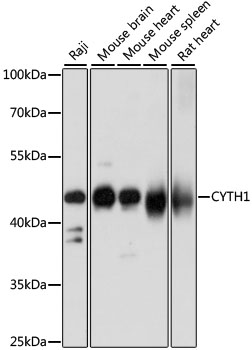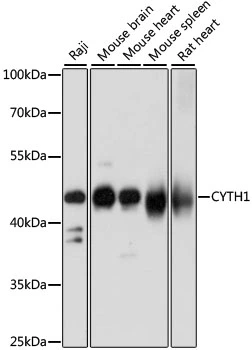Cytohesin 1 antibody [CYT1-82]
GTX12425
ApplicationsImmunoFluorescence, Western Blot, ELISA, ImmunoCytoChemistry
Product group Antibodies
TargetCYTH1
Overview
- SupplierGeneTex
- Product NameCytohesin 1 antibody [CYT1-82]
- Delivery Days Customer9
- Application Supplier NoteWB: 2-4 microg/ml. *Optimal dilutions/concentrations should be determined by the researcher.Not tested in other applications.
- ApplicationsImmunoFluorescence, Western Blot, ELISA, ImmunoCytoChemistry
- CertificationResearch Use Only
- ClonalityMonoclonal
- Clone IDCYT1-82
- Concentration2 mg/ml
- ConjugateUnconjugated
- Gene ID9267
- Target nameCYTH1
- Target descriptioncytohesin 1
- Target synonymsB2-1, CYTOHESIN-1, D17S811E, PSCD1, SEC7, cytohesin-1, PH, SEC7 and coiled-coil domain-containing protein 1, SEC7 homolog B2-1, cytoadhesin 1, homolog of secretory protein SEC7, pleckstrin homology, Sec7 and coiled-coil domains 1
- HostMouse
- IsotypeIgG1
- Protein IDQ15438
- Protein NameCytohesin-1
- Scientific DescriptionARFs (ADP ribosylation factors) are GTP-binding proteins (20 kDa), which catalyze ADP-ribosylation of the alpha-subunit of the adenylyl cyclase-stimulatory G protein. ARFs are active when GTP, but not GDP or ATP, is bound. Hydrolysis of bound GTP to GDP with assistance of GTPase-activating protein results in inactive ARF-GDP. Conversion of ARF-GDP to ARFGTP is promoted by GEP (guanine-exchange protein). Inhibition of GEP activity by brefeldin A (BFA), a fungal metabolite that reversibly causes apparent disintegration of Golgi in cells, has been reported. ARFs have been shown to regulate various aspects of vesicular trafficking pathways in mammalian cells, including endocytosis, phagocytosis, secretion, and endoplasmic reticulum protein transport and budding of transport vesicles from Golgi in both anterograde and retrograde classes (class I: ARFs 1, 2 and 3, class II: ARFs 4 and 5, and class III: ARF 6), based on size, gene structure and sequence identity. The ARF-GEP family, referred to as cytohesins, include cytohesin 1, ARNO (ARF nucleotide binding site opener, also called cytohesin 2), and GRP1 (general receptor for phosphoinositides-1, also known as cytohesin 3 or ARNO3). The members of this family are characterized by an N-terminal coiled-coil domain of 40 amino acids, a Ptdlns (3,4,5)P3-binding C-terminal PH (pleckstrin homology) domain, and a central Sec7 domain. Sec7 is a conserved catalytic domain of approximately 200 amino acids, which stimulates the exchange of GDP to GTP on members of the ARF family of GTPases. The PH domain, by interacting with phospholipids, is believed to be responsible for association of cytoplasm with membranes. Cytohesin 1, the protein product of the B2-1 gene, is a 47 kDa protein. It is abundant in cells of the immune system and is expressed at high levels in natural killer cells and peripheral T lymphocytes, and also expressed at very low levels in purified monocytes and several cultured cell lines. Cytohesin 1 contains two structural motifs: a large central Sec7 domain (200 amino acids) and a carboxy-terminal PH domain (100 amino acids). Overexpression of a cytohesin 1 Sec7 domain fusion protein in Jurkat cells markedly increases cell binding to the extracellular domain of ICAM-1, and direct interaction of the Sec7 domain with the cytoplasmic domain of beta1 integrin was demonstrated in vitro. Cytohesin 1 acts as a GEP that accelerates GTP(yS) and GDP binding to purified native ARF3, and induces ARF binding to Golgi membranes via a mechanism insensitive to BFA. Via its PH domain, cytohesin 1 can bind the lipid product of PI3-Kinase activation, a binding that is visualized through the recruitment of cytohesin-1 to the plasma membrane. Also, granulocytic differentiation of HL-60 cells induced by cAMP results in a marked increase of the levels of endogenous cytohesin 1.
- Storage Instruction-20°C or -80°C,2°C to 8°C
- UNSPSC12352203





![WB analysis of whole cell extracts (30 microg lysate) of Raji (Lane 1), Jurkat (Lane 2) and Hep G2 (Lane 3) using GTX22727 Cytohesin 1 antibody [2E11]. Dilution : 0.5-2 microg/ml](https://www.genetex.com/upload/website/prouct_img/normal/GTX22727/GTX22727_1576_WB_w_23060620_570.webp)
